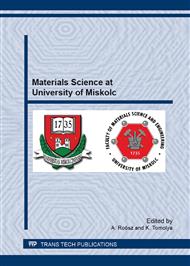p.233
p.241
p.248
p.259
p.268
p.275
p.284
p.294
p.304
Laboratory Preparation and Characterization of Electroless Nickel Coated Powders of Industrially Produced Aluminium and Iron(III) Oxides
Abstract:
Small batches of two oxide powders falling in the particle size range of about 30-230 μm were received from industrial sources and were electroless nickel (EN) coated in order to prepare properly modified reinforcing particles for further laboratory experiments with the Laser Melt Injection (LMI) technique to produce particle reinforced steel composite surface layers. The partially calcined alumina (Al2O3) as well as the hydrothermally recycled crystalline iron(III) oxide precipitate were characterized first to check their exact size ranges, specific surface areas and major chemical contaminants so that the best possible EN plating technique would be selected and applied. It was revealed soon that the sensitization and activation pre-treatment steps could not be omitted and after their proper adjustment, also the composition and pH of a relatively commonly used hypophosphite reducing type bath had to be modified to the given purpose. Eventually a slightly alkaline EN bath was successfully prepared with which both industrial oxide powders surface could be nickel coated soundly, which final result was demonstrated also by several metallographic testing techniques showing the microstructure of the quite evenly and fully coated oxide particles.
Info:
Periodical:
Pages:
284-293
Citation:
Online since:
March 2013
Authors:
Price:
Сopyright:
© 2013 Trans Tech Publications Ltd. All Rights Reserved
Share:
Citation:


